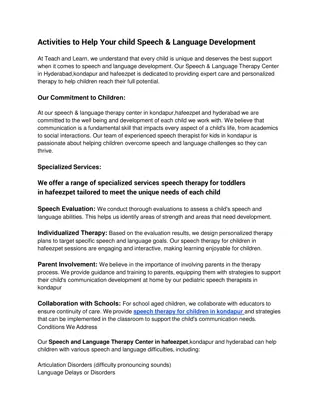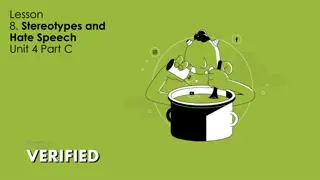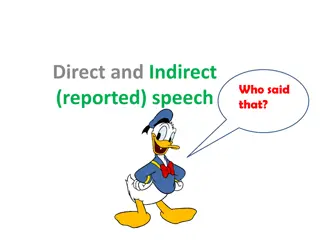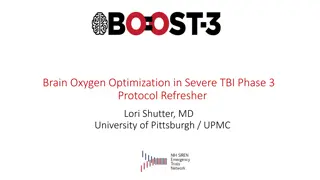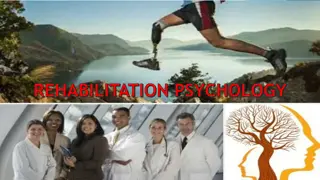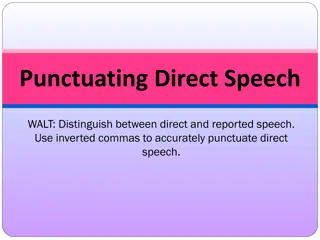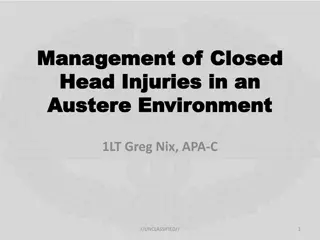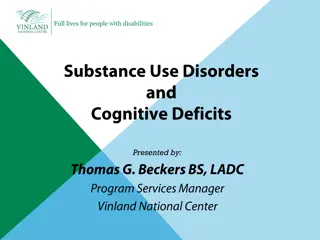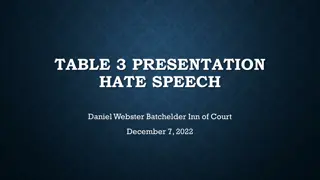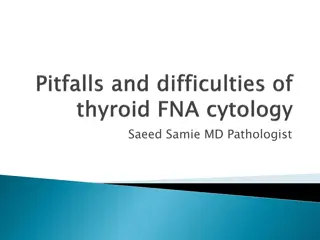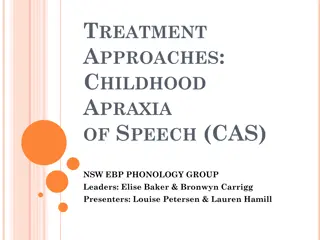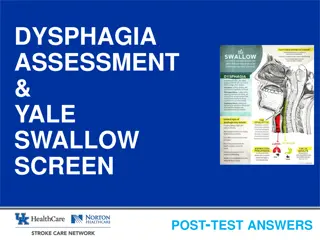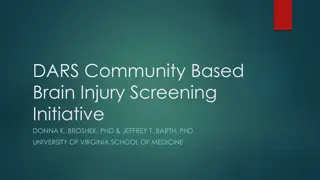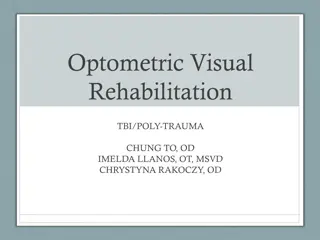Speech-Language Pathologist's Role in TBI Assessment & Treatment
Speech-language pathologists play a crucial role in assessing and treating traumatic brain injuries (TBI) which affect millions annually, with significant impact on children. SLPs collaborate with medical specialists, provide screenings, comprehensive evaluations, treatment development, and advocacy. They are essential in managing speech, language, and swallowing disorders post-TBI, necessitating referral during the acute stage. TBI severity is measured by consciousness loss and specialized scales. The differential diagnosis between closed-head and penetrating injuries further highlights the diverse challenges faced in TBI management.
Download Presentation

Please find below an Image/Link to download the presentation.
The content on the website is provided AS IS for your information and personal use only. It may not be sold, licensed, or shared on other websites without obtaining consent from the author.If you encounter any issues during the download, it is possible that the publisher has removed the file from their server.
You are allowed to download the files provided on this website for personal or commercial use, subject to the condition that they are used lawfully. All files are the property of their respective owners.
The content on the website is provided AS IS for your information and personal use only. It may not be sold, licensed, or shared on other websites without obtaining consent from the author.
E N D
Presentation Transcript
The Role of the Speech- Language Pathologist in the Assessment & Treatment of TBI Cassaundra N. Miller, MS, CCC/SLP West Virginia University Center for Excellence in Disabilities
According to the CDC.. 1.7 million people sustain a TBI every year TBI is a factor in 30% of injury-related deaths Medical costs for TBI total $76 billion a year
Children and TBI Half a million ED visits yearly for ages birth-14 years Children under 4 year at highest risk Limited insight into impact on adult milestones History of childhood TBI results in lower educational attainment & higher incarceration rates Difficulty accessing appropriate services
Closed-Head & Penetrating Injuries Closed-Head Injury Skull remains intact Often diffuse damage Includes: Concussions Coup/Contrecoup Diffuse axonal injuries Contusions Hematomas Penetrating Head Injury Insult to skull and/or dura More focal damage Occurs from: High velocity projectiles Skull fracture fragments
According to The American Speech Language Hearing Association s (ASHA) Evidence Map for Pediatric Brain Injury SLPs and medical specialists are essential for the management of speech, language, and swallowing disorders, and should be referred during the acute stage.
Roles and Responsibilities of the SLP Screenings Comprehensive evaluations Development & implementation of treatment Counseling regarding SLP specific impairments Collaboration with interdisciplinary team Knowledgeable on recent research Advocating Risk management & quality control
TBI Severity Measurements Loss of Consciousness Rancho Los Amigos Scale Glasgow Coma Scale Post-Traumatic Amnesia
Loss of Consciousness (LOC) TBI Classification Coma Duration Mild < 20 minutes Moderate < 6 hours Severe > 6 hours after admission
Glasgow Coma Scale (GSC) Cornerstone of physical examination Consistent, numeric way to describe TBI Guides initial treatment Monitors responsiveness Modified Pediatric Glasgow Coma Scale for children under age 5 Glasgow Coma Scale-Pupils Score developed in 2018 and includes Pupil Reactivity Score
Glasgow Coma Scale Scoring Eye Opening Response Verbal Response Motor Response Spontaneous 4 pts Oriented 5 pts Obeys commands 6 pts To verbal stim 3 pts Confused, but answers questions 4 pts Purposeful movement in response to pain 5 pts To pain only 2 pts Inappropriate words 3 pts Withdraws from pain 4 pts No response 1 pt Incomprehensible 2 pts Flexion in response to pain 3 pts No response 1 pt Extension in response to pain 2 pts No response 1 pt
Glasgow Coma Scale Severity Ratings Glasgow Score Severity Rating 13 to 15 Mild 9 to 12 Moderate 8 or less Severe
Post-Traumatic Amnesia Impaired recall of events surrounding TBI Time surrounding a TBI that patient is confused Assessed by orientation Longer period of confusion associated with worse immediate outcomes & slower recovery
RANCHO LOS AMIGOS Scale of Cognitive Functioning Measures & identifies recovery patterns of TBI No specific training Administered multiple times throughout recovery Insight into executive functioning, behavior, and safety awareness Impacts treatment and discharge planning
Rancho Level Behavior Description I No response II Generalized response, non-purposeful III Localized Response, purposeful IV Confused, agitated, aggressive V Confused, inappropriate, highly distractible VI Confused, appropriate, severe memory difficulties VII Automatic, appropriate, lacking insight VIII Purposeful, oriented, decreased premorbid reasoning
Dysphagia & TBI Dysphagia occurs in 33% of patients with TBI 60% of patients with severe TBI have dysphagia Relationship between Length of coma Tracheostomy tube/ ventilator Severity of dysphagia
Tracheostomy Tube Tube inserted into stoma in neck Assists with breathing Can be used with or without ventilator Speaking valve allows talking Eating can occur
Dysphagia Assessment Measures Oral Peripheral Exam Bedside Swallow Evaluation Functional Feeding Assessment Instrumental Measures
Modified Barium Swallow Study Video x-ray study Barium added to food Monitor for safety Helps determine diet Some patient limitations
Fiberoptic Endoscopic Evaluation of Swallow Flexible scope passed through the nose Camera with light attached to the scope Can be performed most patients Short whiteout period
Dysphagia Treatment Modalities Compensatory Strategies Therapeutic Feeds Positioning Equipment Electrical stimulation
Diet Modifications Solids and liquids are modified for safety Helps to decrease fatigue Reduces aspiration risk Previously based on National Dysphagia Diet Moving towards IDDSI
Alternative Nutrition Not all patients can tolerate food by mouth Very impaired swallow Decreased arousal level On ventilator Alternative Nutrition Methods TPN NG tube G tube Mixed
Assessment Procedures for Cognition & Communication After TBI
Cognitive-Communication Testing Considerations Formalized testing MUST be normed for patients with TBI Many factors affect testing reliability Arousal Depression Agitation Motor deficits Sensory impairments
Cognitive-Communication Testing Monitoring of Glasgow & Rancho Levels Cognitive-Linguistic Quick Test Includes Clock Drawing SCATBI ASHA-FACS FAVRES
Pediatric Specific Testing Pediatric Test of Brain Injury Only standardized pediatric assessment for brain injury FAVRES Adolescent specific portion CELF-5 Includes metalinguistic component
Cognitive- Communication Impairments in TBI
Speech & Language Deficits in Patients with TBI Expressive Language Receptive Language Reading & Writing Pragmatics/Social Language
Discourse Analysis & Conversational Speech Discourse deficits are a hallmark of TBI Socially isolating Discourse analysis best evidence based practice Intervention should be based on cognitive deficits
Cognitive Deficits in Patients with TBI Memory Attention Executive functioning Insight
Treatment for Cognitive-Communication Deficits Functional patient-centered goals Collaborative team approach High therapy frequency Group & individual intervention Evidence Based Practice
Compensatory Strategies Support success and independence by utilizing intact skills to overcome challenges
Errorless Learning Correct Practice Patient feels successful Small steps Provide multiple models Fade out prompts
Metacognitive Skill Training Patients think about thinking Increases problem-solving skills Tasks are broken down into small steps 1. Setting Goals 2. Self-monitoring of performance 3. Evaluation
Augmentative & Alternative Communication Supplements communication Changes throughout treatment No-tech, low-tech or high-tech Decreases agitation or frustration Increases independence Can support speech development
Motor Speech Intervention Increase speech & speech intelligibility Targets apraxia & dysarthria Tactile, visual, auditory cues Modalities such as massage
Caregiver Stressors Time off work Decreased income Caregiver burden Concern for loved one Increased anxiety & depression Parental distress increases child behaviors
Questions? Thank you!
References ASHA www.asha.org - AAC Practice Portal - Pediatric Brain Injury Evidence Map - Pediatric Brain Injury Practice Portal - Adult Traumatic Brain Injury Practice Portal Centers for Disease Control www.cdc.gov - Traumatic Brain Injury & Concussion - Report to Congress. The Management of Traumatic Brain Injury in Children: Opportunities for Action - Mass Trauma Resources Glasgow Coma Scale
References Glasgow Structured Approach to Assessment of the Glasgow Coma Scale www.glasgowcomascale.org Narad, M.; Yeates, K.; Taylor, H.; Stancin, T.; Wade, S. (2016) Maternal and Paternal Distress and Coping Over Time Following Pediatric Traumatic Brain Injury Le, K.; Mozeiko, J.; Coelho, C. (2011). Discourse Analyses: Characterizing Cognitive-Communication Disorders following TBI Ness, B. & Sohlberg, M. (2009). Implementing Metacognitive Strategies Targeting Self-Regulation for Adolescents in Resource Settings Patterson, F.; Fleming, J.; Doig, E. (2016) Group-based Delivery of Interventions in Traumatic Brain Injury Rehabilitation: A Scoping Review
References YouTube My X Ray Swallows Intra Swallow Aspiration Fiberoptic Endoscopic Evaluation of Swallowing Aspiration Before the Swallow with Thin Liquids by Cup IDDSI Flow Test Zollman, Felise S. (2011). Manual of Traumatic Brain Injury Management





